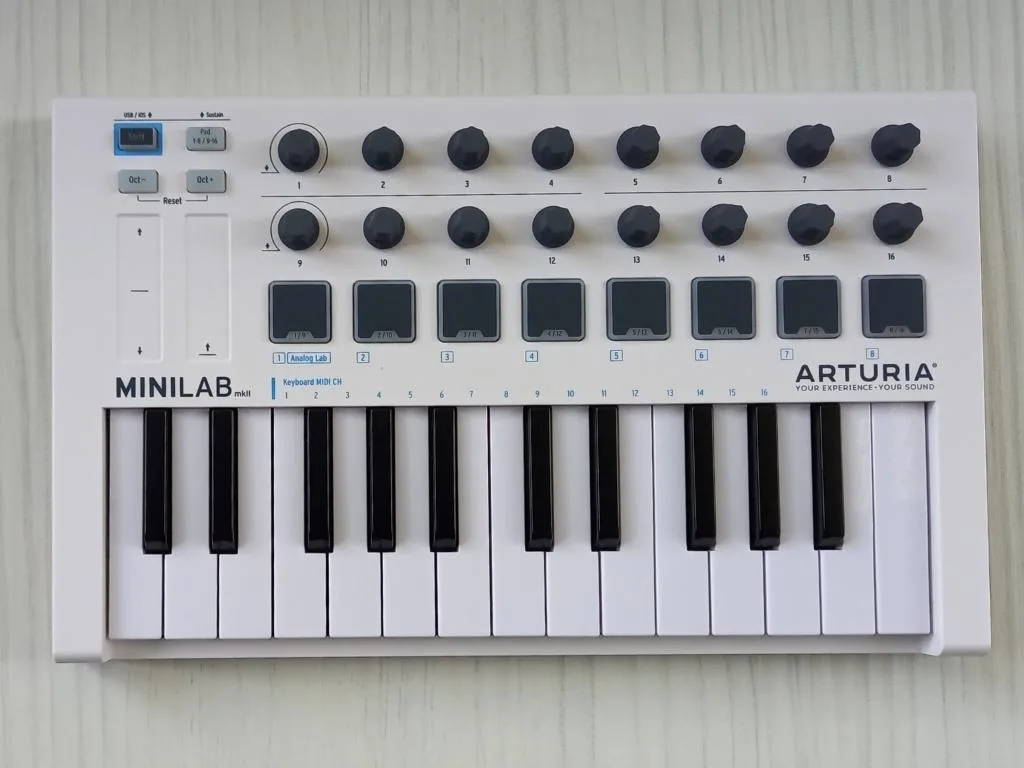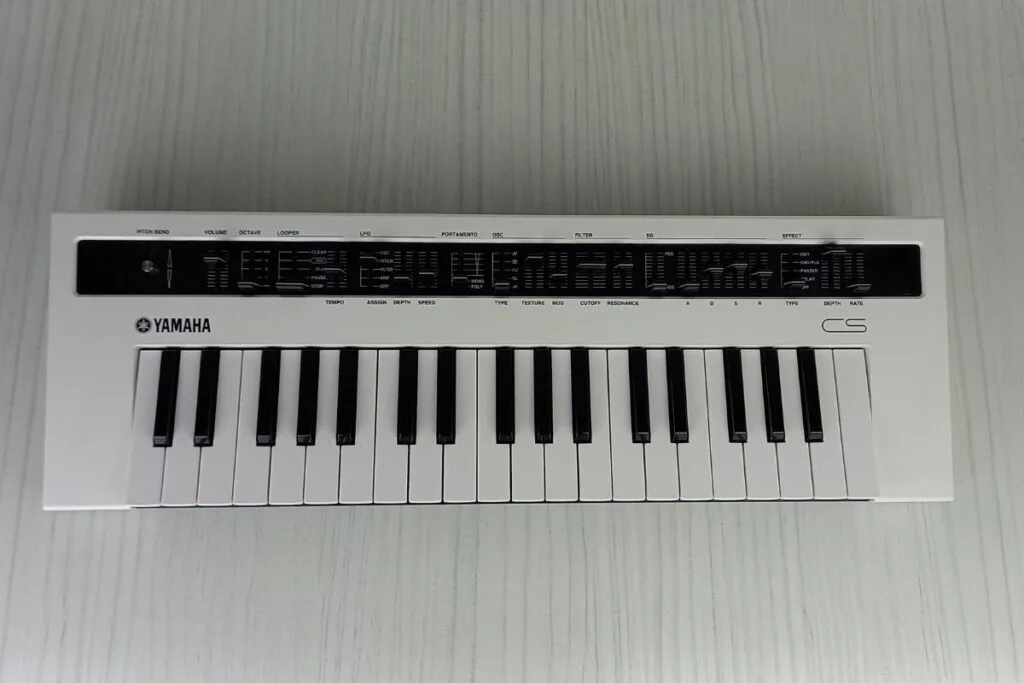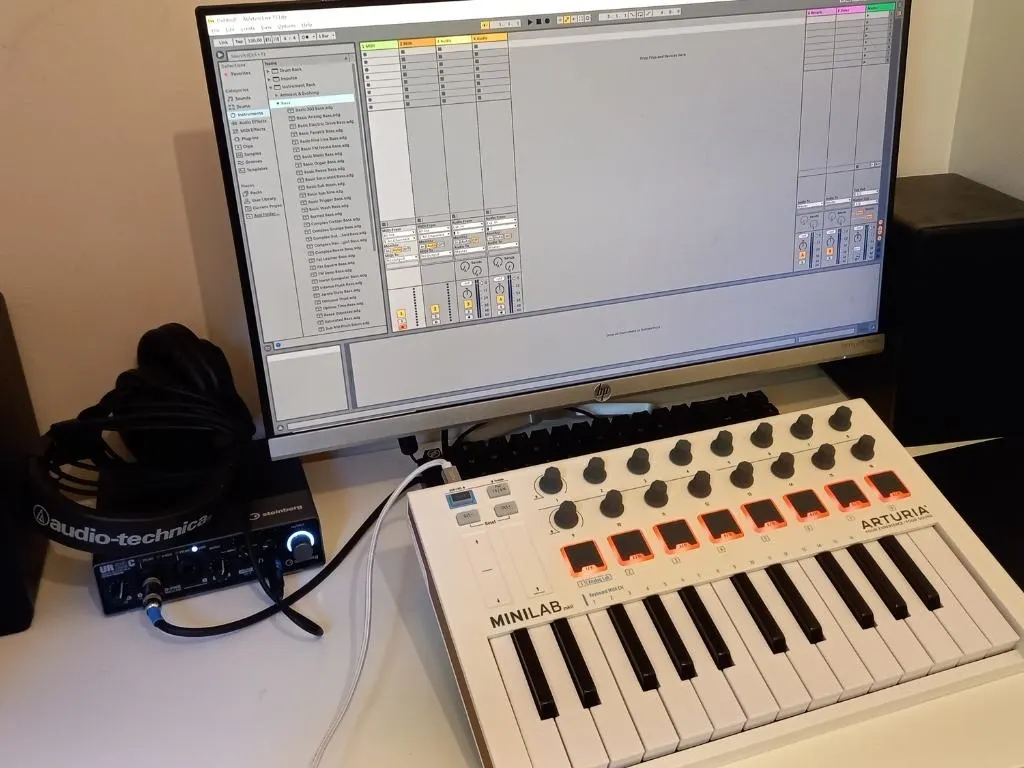When I first started making music, I didn’t know the difference between a MIDI keyboard vs a synthesizer. They both have keys, controls, and a similar shape… I didn’t understand that they were completely different things!
It’s a common problem that a lot of beginner music producers face, and can be a disappointing (and costly!) mistake if you end up buying the wrong one.
As an owner of both a MIDI keyboard and a synthesizer, I’ve written this article teaching you what a MIDI keyboard and synthesizer is, the differences between them, and which one you should buy.
What are MIDI keyboards and synthesizers?
To understand the difference between a MIDI keyboard and a synthesizer, it’s important to know what they’re used for. So, here’s a quick overview.
MIDI keyboards
A MIDI keyboard is a type of MIDI controller that looks like a traditional “piano-style” keyboard. They’re used to control a connected device, using digital instructions called “MIDI“. These MIDI messages tell the connected piece of equipment what to do.
For example, pressing a key on a MIDI keyboard would send a MIDI message to the connected device to play the corresponding note of that key.
As well as keys, they usually include other controls like buttons and knobs that can adjust different settings on a connected device, usually a Digital Audio Workstation (DAW). As you can imagine, this makes working with software feel a lot more natural.

MIDI keyboards have a lot of different uses, from controlling virtual instruments on your PC (called “VST’s”) to playing multiple hardware devices. Think of them as a “brain” that tells the different devices what to do.
The key thing about MIDI keyboards, though, is that they don’t produce sounds – they only send instructions to other connected devices. So, if you’re looking to make music with a MIDI keyboard, you’ll either need a DAW or another MIDI-capable device to connect to.
I’ve written an in-depth article on this website that explains everything you need to know about MIDI controllers. I recommend checking it out, as it covers this in a lot more detail.
Synthesizers
Synthesizers are electronic musical instruments. You’ll have heard them in songs like “Jump” by Van Halen, “Cars” by Gary Numan, “Tom Sawyer” by Rush… basically anything from the 1980s.
Explaining how synthesizers work is pretty complex. Suffice it to say: they work by creating an electronic audio signal which is then processed and changed by onboard filters and effects to produce new textures and sounds.

Most synthesizers come with built-in piano-style keys. As you’d expect, these keys tell the synthesizer which pitch to play.
But, they also include different controls, like buttons and sliders, that control the filters, envelopes, and other settings. As such, they can look very similar to a MIDI keyboard, which can lead to confusion.
The thing you need to know is that a synthesizer produces its own sound.
Interestingly, most modern synthesizers can also send and receive MIDI messages, meaning that you can also use them as a MIDI keyboard.
What’s the difference between them?
So, now we know what they’re used for, let’s take a look at the differences between MIDI keyboards and synthesizers.
MIDI keyboards don’t produce sounds
The biggest difference between a MIDI keyboard and a synthesizer is that MIDI keyboards doesn’t produce a sound, but a synthesizer does.
Instead, MIDI keyboards send instructions to a connected device telling it what to do. The most common use is to tell a virtual instrument on a PC which note(s) to play. By pressing the keys on the MIDI keyboard, you can “play” the virtual instrument in real-time.

So, you can use a MIDI keyboard to make and perform music, but the sound comes from whatever instrument you’re connecting to.
A synthesizer, on the other hand, makes its own sound. They contain complex electronics that generate and transform waveforms. Most modern synths come with built in keys which control the pitch, like a traditional piano or keyboard.
Because of this difference, it’s helpful to think of a synth as a musical instrument and a MIDI keyboard as more of a musical tool.
MIDI keyboards are generally cheaper
Another key difference between MIDI keyboards and synthesizers is price. MIDI keyboards are much cheaper than synthesizers, as they contain simpler electronics.
Depending on what functionality you want, you can pick up a MIDI keyboard for less than $50. A synthesizer will cost you a lot more. An entry level synth, like the Korg Monologue, will cost you upwards of $300. More complex synths, like most Moog synthesizers, cost around $1500. And vintage synthesizers will easily cost you more.
For this reason, a lot of beginner music producers start with a MIDI keyboard and a PC loaded with multiple synthesizer VST’s. This gives you a very wide range of sounds for a fraction of the price.
In fact, some MIDI keyboards come with all the software you need to make music, including some free VST’s. Like the free synth software I covered in my review of the Arturia MiniLab MKII.
Which one should you buy?
So, which one do you get: a MIDI keyboard or a synth?
It’ll vary from person-to-person, but here’s my general advice: if you want an affordable and effective way to produce music on a PC, buy a MIDI keyboard. If you’re looking for a specific sound, or want a synth without being dependent on a PC, then buy a synthesizer.
That being said, let’s take a look in some more detail.
Reasons to buy a MIDI keyboard
MIDI keyboards are an essential tool for music producers working with a DAW. In my experience, you’re not going to get very far without one. Luckily, they’re one of the cheapest (and most effective) pieces of equipment you can buy for your home-studio setup.
Here’s why I’d recommend buying a MIDI keyboard:
- They’re very affordable
- They’re easy to use (and make using a DAW a lot easier!)
- They can simplify complex setups (e.g. controlling multiple connected instruments)
- They’re lightweight and portable (pair them with a laptop, and you’ve got a portable studio)
If this sounds like something you’re looking for, then a MIDI keyboard is probably for you. Again, I recommend checking out my article on MIDI controllers to see the benefits in more depth, and the different types of controllers available.
Reasons to buy a synthesizer
Synthesizers have a more specific function than a MIDI keyboard. They’re an instrument in their own right, much like a guitar or drum kit. As such, there’s a bit more thought that goes into buying them
Here’s why I’d recommend buying a synthesizer:
- If you’re looking for an authentic synth sound
- You don’t want to be dependent on a PC
- You want the experience of playing a physical instrument
- They hold their value (good for reselling later on!)
- Most can double-up as MIDI keyboards (you get a two-in-one solution)
For me, I see synthesizers as something you buy because you specifically want the sound and playing experience of a synthesizer. Sure, you can get synth VST’s, but they’re never quite the real thing.
Summary
There we have it! When it comes to the great MIDI keyboard vs synthesizer debate, it’s like comparing apples and oranges. They’re completely different beasts, but have a little overlap.
Here’s a final summary:
- MIDI keyboards don’t generate their own sounds, whereas synthesizers do
- MIDI keyboards are used to control connected MIDI-capable devices, but synthesizers are an electronic instrument
- MIDI keyboards are much cheaper than synthesizers
- Some synthesizer can be used as a MIDI keyboard
- If you’re a beginner music producer working with music software on a PC, I recommend buying a MIDI keyboard
Frequently asked questions

Conor is a music producer, multi-instrumentalist, and all-round enthusiast from the UK with over 15 years of experience. He’s the founder and sole-content creator for the roundtable audio blog and YouTube channel.
